UTS Nursing Care of Older Person: Person-Centred Care Plan
VerifiedAdded on 2022/10/03
|14
|3458
|417
Essay
AI Summary
This essay presents a comprehensive nursing care plan designed for an 80-year-old woman, Laura, who experiences complications from osteoporosis and cataracts. The plan emphasizes person-centered care, acknowledging her unique needs and preferences. It begins with a critical reflection on a conversation with Laura, highlighting her physical and psychological challenges, including hip fracture, vision impairment, diabetes, and lifestyle factors such as smoking and drinking. The essay incorporates a review of relevant literature on osteoporosis, cataracts, and diabetes, drawing on studies to support the chosen interventions. The care plan includes educational sessions, support from health professionals (ophthalmologists, endocrinologists, and physiotherapists), community involvement, and dietary and exercise recommendations. The discussion addresses potential challenges and emphasizes the importance of communication and building a therapeutic relationship. The conclusion reiterates the patient-centered approach, stressing the need for consistent support to improve Laura's quality of life and reduce health complications through regular assessments and social interactions.

Running head: NURSING
Nursing
Name of the Student
Name of the University
Author Note
Nursing
Name of the Student
Name of the University
Author Note
Paraphrase This Document
Need a fresh take? Get an instant paraphrase of this document with our AI Paraphraser
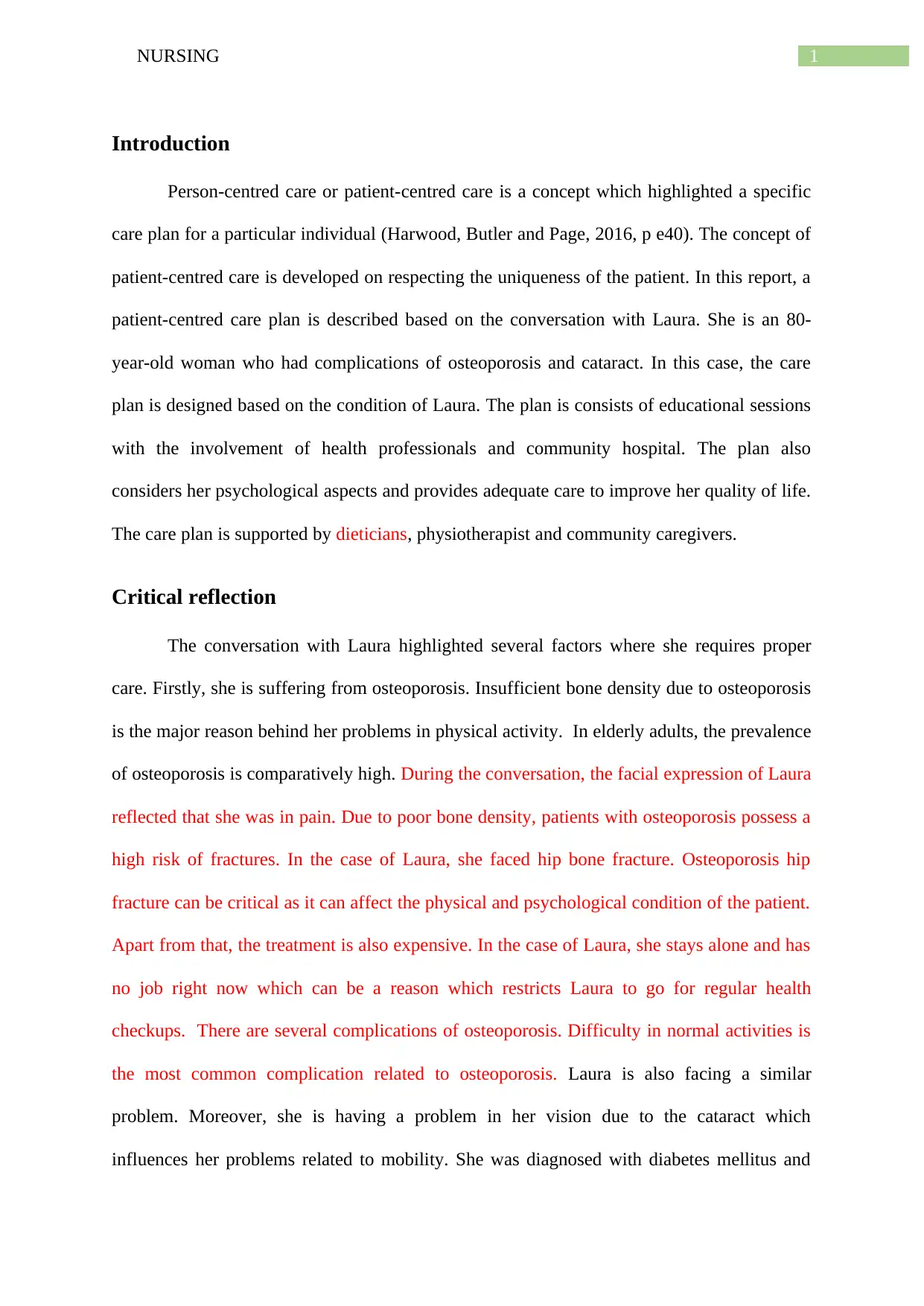
1NURSING
Introduction
Person-centred care or patient-centred care is a concept which highlighted a specific
care plan for a particular individual (Harwood, Butler and Page, 2016, p e40). The concept of
patient-centred care is developed on respecting the uniqueness of the patient. In this report, a
patient-centred care plan is described based on the conversation with Laura. She is an 80-
year-old woman who had complications of osteoporosis and cataract. In this case, the care
plan is designed based on the condition of Laura. The plan is consists of educational sessions
with the involvement of health professionals and community hospital. The plan also
considers her psychological aspects and provides adequate care to improve her quality of life.
The care plan is supported by dieticians, physiotherapist and community caregivers.
Critical reflection
The conversation with Laura highlighted several factors where she requires proper
care. Firstly, she is suffering from osteoporosis. Insufficient bone density due to osteoporosis
is the major reason behind her problems in physical activity. In elderly adults, the prevalence
of osteoporosis is comparatively high. During the conversation, the facial expression of Laura
reflected that she was in pain. Due to poor bone density, patients with osteoporosis possess a
high risk of fractures. In the case of Laura, she faced hip bone fracture. Osteoporosis hip
fracture can be critical as it can affect the physical and psychological condition of the patient.
Apart from that, the treatment is also expensive. In the case of Laura, she stays alone and has
no job right now which can be a reason which restricts Laura to go for regular health
checkups. There are several complications of osteoporosis. Difficulty in normal activities is
the most common complication related to osteoporosis. Laura is also facing a similar
problem. Moreover, she is having a problem in her vision due to the cataract which
influences her problems related to mobility. She was diagnosed with diabetes mellitus and
Introduction
Person-centred care or patient-centred care is a concept which highlighted a specific
care plan for a particular individual (Harwood, Butler and Page, 2016, p e40). The concept of
patient-centred care is developed on respecting the uniqueness of the patient. In this report, a
patient-centred care plan is described based on the conversation with Laura. She is an 80-
year-old woman who had complications of osteoporosis and cataract. In this case, the care
plan is designed based on the condition of Laura. The plan is consists of educational sessions
with the involvement of health professionals and community hospital. The plan also
considers her psychological aspects and provides adequate care to improve her quality of life.
The care plan is supported by dieticians, physiotherapist and community caregivers.
Critical reflection
The conversation with Laura highlighted several factors where she requires proper
care. Firstly, she is suffering from osteoporosis. Insufficient bone density due to osteoporosis
is the major reason behind her problems in physical activity. In elderly adults, the prevalence
of osteoporosis is comparatively high. During the conversation, the facial expression of Laura
reflected that she was in pain. Due to poor bone density, patients with osteoporosis possess a
high risk of fractures. In the case of Laura, she faced hip bone fracture. Osteoporosis hip
fracture can be critical as it can affect the physical and psychological condition of the patient.
Apart from that, the treatment is also expensive. In the case of Laura, she stays alone and has
no job right now which can be a reason which restricts Laura to go for regular health
checkups. There are several complications of osteoporosis. Difficulty in normal activities is
the most common complication related to osteoporosis. Laura is also facing a similar
problem. Moreover, she is having a problem in her vision due to the cataract which
influences her problems related to mobility. She was diagnosed with diabetes mellitus and
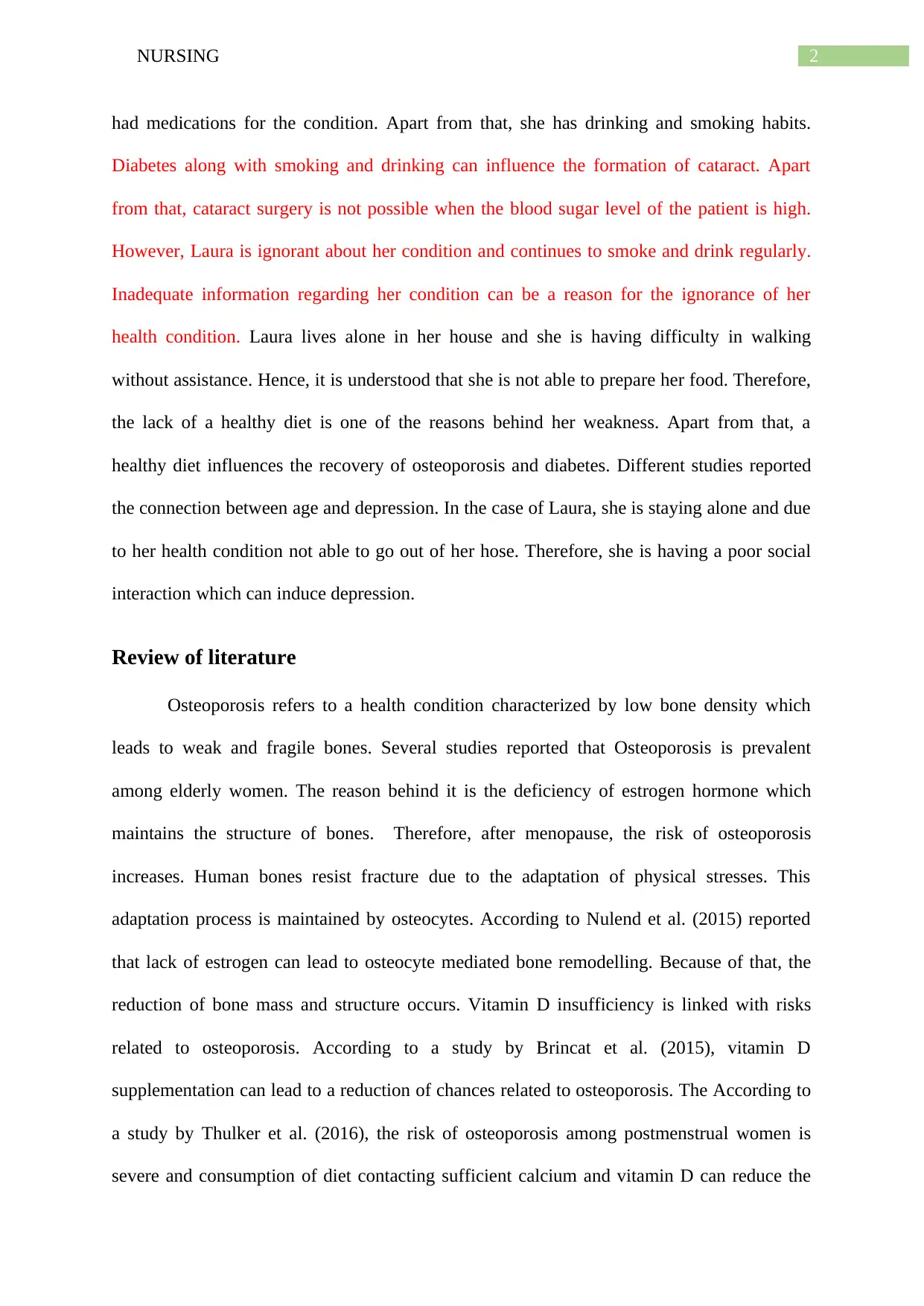
2NURSING
had medications for the condition. Apart from that, she has drinking and smoking habits.
Diabetes along with smoking and drinking can influence the formation of cataract. Apart
from that, cataract surgery is not possible when the blood sugar level of the patient is high.
However, Laura is ignorant about her condition and continues to smoke and drink regularly.
Inadequate information regarding her condition can be a reason for the ignorance of her
health condition. Laura lives alone in her house and she is having difficulty in walking
without assistance. Hence, it is understood that she is not able to prepare her food. Therefore,
the lack of a healthy diet is one of the reasons behind her weakness. Apart from that, a
healthy diet influences the recovery of osteoporosis and diabetes. Different studies reported
the connection between age and depression. In the case of Laura, she is staying alone and due
to her health condition not able to go out of her hose. Therefore, she is having a poor social
interaction which can induce depression.
Review of literature
Osteoporosis refers to a health condition characterized by low bone density which
leads to weak and fragile bones. Several studies reported that Osteoporosis is prevalent
among elderly women. The reason behind it is the deficiency of estrogen hormone which
maintains the structure of bones. Therefore, after menopause, the risk of osteoporosis
increases. Human bones resist fracture due to the adaptation of physical stresses. This
adaptation process is maintained by osteocytes. According to Nulend et al. (2015) reported
that lack of estrogen can lead to osteocyte mediated bone remodelling. Because of that, the
reduction of bone mass and structure occurs. Vitamin D insufficiency is linked with risks
related to osteoporosis. According to a study by Brincat et al. (2015), vitamin D
supplementation can lead to a reduction of chances related to osteoporosis. The According to
a study by Thulker et al. (2016), the risk of osteoporosis among postmenstrual women is
severe and consumption of diet contacting sufficient calcium and vitamin D can reduce the
had medications for the condition. Apart from that, she has drinking and smoking habits.
Diabetes along with smoking and drinking can influence the formation of cataract. Apart
from that, cataract surgery is not possible when the blood sugar level of the patient is high.
However, Laura is ignorant about her condition and continues to smoke and drink regularly.
Inadequate information regarding her condition can be a reason for the ignorance of her
health condition. Laura lives alone in her house and she is having difficulty in walking
without assistance. Hence, it is understood that she is not able to prepare her food. Therefore,
the lack of a healthy diet is one of the reasons behind her weakness. Apart from that, a
healthy diet influences the recovery of osteoporosis and diabetes. Different studies reported
the connection between age and depression. In the case of Laura, she is staying alone and due
to her health condition not able to go out of her hose. Therefore, she is having a poor social
interaction which can induce depression.
Review of literature
Osteoporosis refers to a health condition characterized by low bone density which
leads to weak and fragile bones. Several studies reported that Osteoporosis is prevalent
among elderly women. The reason behind it is the deficiency of estrogen hormone which
maintains the structure of bones. Therefore, after menopause, the risk of osteoporosis
increases. Human bones resist fracture due to the adaptation of physical stresses. This
adaptation process is maintained by osteocytes. According to Nulend et al. (2015) reported
that lack of estrogen can lead to osteocyte mediated bone remodelling. Because of that, the
reduction of bone mass and structure occurs. Vitamin D insufficiency is linked with risks
related to osteoporosis. According to a study by Brincat et al. (2015), vitamin D
supplementation can lead to a reduction of chances related to osteoporosis. The According to
a study by Thulker et al. (2016), the risk of osteoporosis among postmenstrual women is
severe and consumption of diet contacting sufficient calcium and vitamin D can reduce the
⊘ This is a preview!⊘
Do you want full access?
Subscribe today to unlock all pages.

Trusted by 1+ million students worldwide
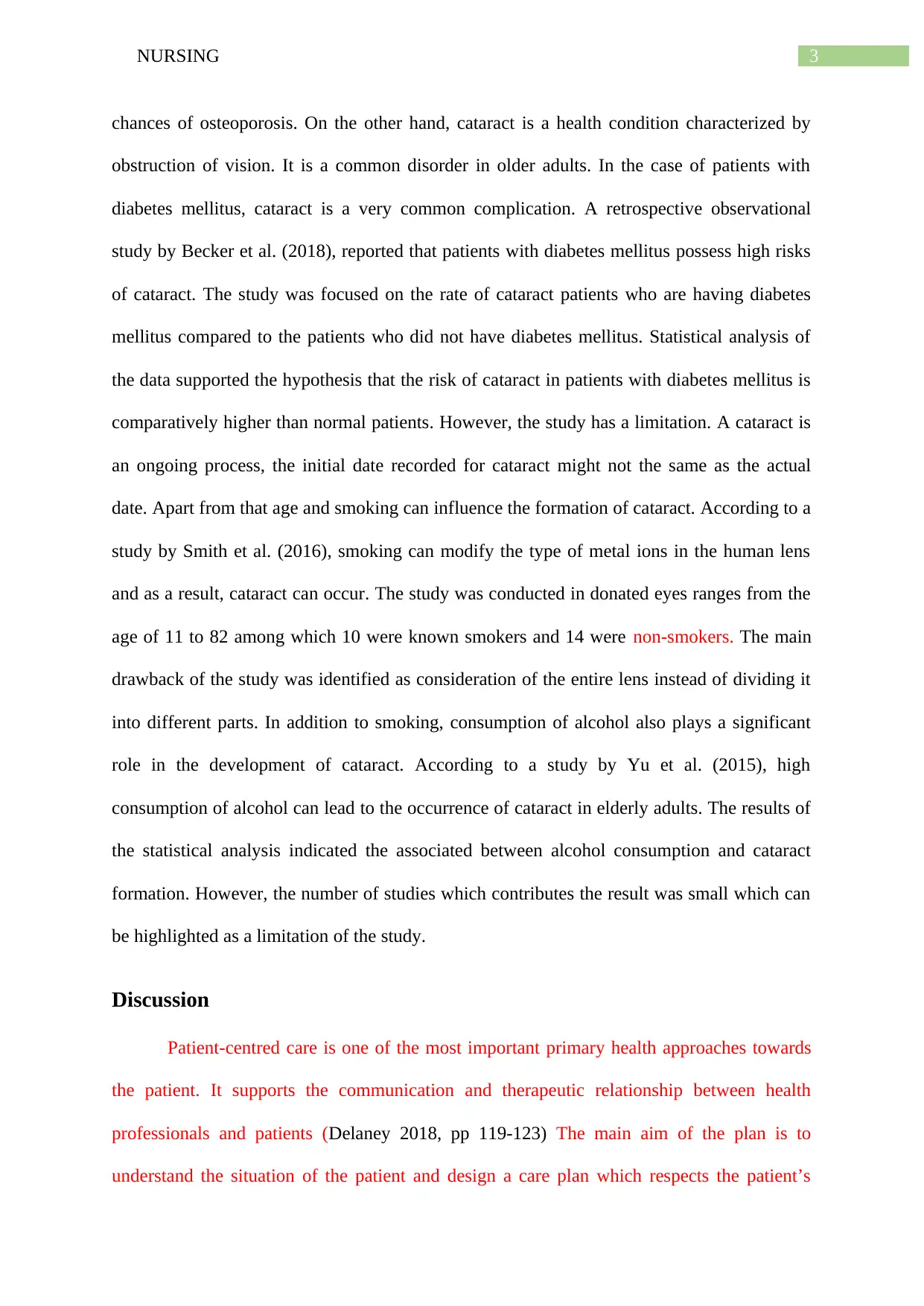
3NURSING
chances of osteoporosis. On the other hand, cataract is a health condition characterized by
obstruction of vision. It is a common disorder in older adults. In the case of patients with
diabetes mellitus, cataract is a very common complication. A retrospective observational
study by Becker et al. (2018), reported that patients with diabetes mellitus possess high risks
of cataract. The study was focused on the rate of cataract patients who are having diabetes
mellitus compared to the patients who did not have diabetes mellitus. Statistical analysis of
the data supported the hypothesis that the risk of cataract in patients with diabetes mellitus is
comparatively higher than normal patients. However, the study has a limitation. A cataract is
an ongoing process, the initial date recorded for cataract might not the same as the actual
date. Apart from that age and smoking can influence the formation of cataract. According to a
study by Smith et al. (2016), smoking can modify the type of metal ions in the human lens
and as a result, cataract can occur. The study was conducted in donated eyes ranges from the
age of 11 to 82 among which 10 were known smokers and 14 were non-smokers. The main
drawback of the study was identified as consideration of the entire lens instead of dividing it
into different parts. In addition to smoking, consumption of alcohol also plays a significant
role in the development of cataract. According to a study by Yu et al. (2015), high
consumption of alcohol can lead to the occurrence of cataract in elderly adults. The results of
the statistical analysis indicated the associated between alcohol consumption and cataract
formation. However, the number of studies which contributes the result was small which can
be highlighted as a limitation of the study.
Discussion
Patient-centred care is one of the most important primary health approaches towards
the patient. It supports the communication and therapeutic relationship between health
professionals and patients (Delaney 2018, pp 119-123) The main aim of the plan is to
understand the situation of the patient and design a care plan which respects the patient’s
chances of osteoporosis. On the other hand, cataract is a health condition characterized by
obstruction of vision. It is a common disorder in older adults. In the case of patients with
diabetes mellitus, cataract is a very common complication. A retrospective observational
study by Becker et al. (2018), reported that patients with diabetes mellitus possess high risks
of cataract. The study was focused on the rate of cataract patients who are having diabetes
mellitus compared to the patients who did not have diabetes mellitus. Statistical analysis of
the data supported the hypothesis that the risk of cataract in patients with diabetes mellitus is
comparatively higher than normal patients. However, the study has a limitation. A cataract is
an ongoing process, the initial date recorded for cataract might not the same as the actual
date. Apart from that age and smoking can influence the formation of cataract. According to a
study by Smith et al. (2016), smoking can modify the type of metal ions in the human lens
and as a result, cataract can occur. The study was conducted in donated eyes ranges from the
age of 11 to 82 among which 10 were known smokers and 14 were non-smokers. The main
drawback of the study was identified as consideration of the entire lens instead of dividing it
into different parts. In addition to smoking, consumption of alcohol also plays a significant
role in the development of cataract. According to a study by Yu et al. (2015), high
consumption of alcohol can lead to the occurrence of cataract in elderly adults. The results of
the statistical analysis indicated the associated between alcohol consumption and cataract
formation. However, the number of studies which contributes the result was small which can
be highlighted as a limitation of the study.
Discussion
Patient-centred care is one of the most important primary health approaches towards
the patient. It supports the communication and therapeutic relationship between health
professionals and patients (Delaney 2018, pp 119-123) The main aim of the plan is to
understand the situation of the patient and design a care plan which respects the patient’s
Paraphrase This Document
Need a fresh take? Get an instant paraphrase of this document with our AI Paraphraser
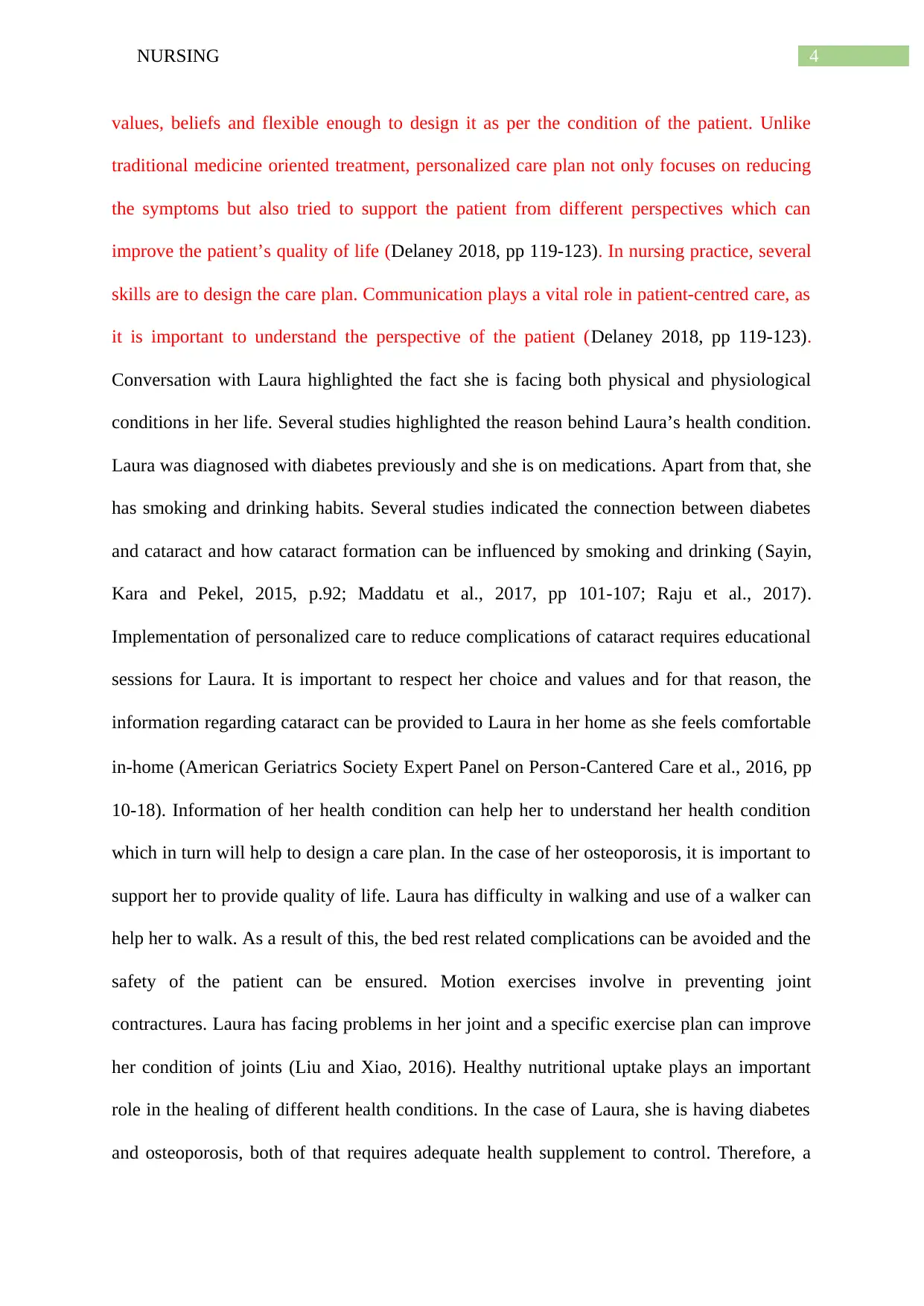
4NURSING
values, beliefs and flexible enough to design it as per the condition of the patient. Unlike
traditional medicine oriented treatment, personalized care plan not only focuses on reducing
the symptoms but also tried to support the patient from different perspectives which can
improve the patient’s quality of life (Delaney 2018, pp 119-123). In nursing practice, several
skills are to design the care plan. Communication plays a vital role in patient-centred care, as
it is important to understand the perspective of the patient (Delaney 2018, pp 119-123).
Conversation with Laura highlighted the fact she is facing both physical and physiological
conditions in her life. Several studies highlighted the reason behind Laura’s health condition.
Laura was diagnosed with diabetes previously and she is on medications. Apart from that, she
has smoking and drinking habits. Several studies indicated the connection between diabetes
and cataract and how cataract formation can be influenced by smoking and drinking (Sayin,
Kara and Pekel, 2015, p.92; Maddatu et al., 2017, pp 101-107; Raju et al., 2017).
Implementation of personalized care to reduce complications of cataract requires educational
sessions for Laura. It is important to respect her choice and values and for that reason, the
information regarding cataract can be provided to Laura in her home as she feels comfortable
in-home (American Geriatrics Society Expert Panel on Person‐Cantered Care et al., 2016, pp
10-18). Information of her health condition can help her to understand her health condition
which in turn will help to design a care plan. In the case of her osteoporosis, it is important to
support her to provide quality of life. Laura has difficulty in walking and use of a walker can
help her to walk. As a result of this, the bed rest related complications can be avoided and the
safety of the patient can be ensured. Motion exercises involve in preventing joint
contractures. Laura has facing problems in her joint and a specific exercise plan can improve
her condition of joints (Liu and Xiao, 2016). Healthy nutritional uptake plays an important
role in the healing of different health conditions. In the case of Laura, she is having diabetes
and osteoporosis, both of that requires adequate health supplement to control. Therefore, a
values, beliefs and flexible enough to design it as per the condition of the patient. Unlike
traditional medicine oriented treatment, personalized care plan not only focuses on reducing
the symptoms but also tried to support the patient from different perspectives which can
improve the patient’s quality of life (Delaney 2018, pp 119-123). In nursing practice, several
skills are to design the care plan. Communication plays a vital role in patient-centred care, as
it is important to understand the perspective of the patient (Delaney 2018, pp 119-123).
Conversation with Laura highlighted the fact she is facing both physical and physiological
conditions in her life. Several studies highlighted the reason behind Laura’s health condition.
Laura was diagnosed with diabetes previously and she is on medications. Apart from that, she
has smoking and drinking habits. Several studies indicated the connection between diabetes
and cataract and how cataract formation can be influenced by smoking and drinking (Sayin,
Kara and Pekel, 2015, p.92; Maddatu et al., 2017, pp 101-107; Raju et al., 2017).
Implementation of personalized care to reduce complications of cataract requires educational
sessions for Laura. It is important to respect her choice and values and for that reason, the
information regarding cataract can be provided to Laura in her home as she feels comfortable
in-home (American Geriatrics Society Expert Panel on Person‐Cantered Care et al., 2016, pp
10-18). Information of her health condition can help her to understand her health condition
which in turn will help to design a care plan. In the case of her osteoporosis, it is important to
support her to provide quality of life. Laura has difficulty in walking and use of a walker can
help her to walk. As a result of this, the bed rest related complications can be avoided and the
safety of the patient can be ensured. Motion exercises involve in preventing joint
contractures. Laura has facing problems in her joint and a specific exercise plan can improve
her condition of joints (Liu and Xiao, 2016). Healthy nutritional uptake plays an important
role in the healing of different health conditions. In the case of Laura, she is having diabetes
and osteoporosis, both of that requires adequate health supplement to control. Therefore, a
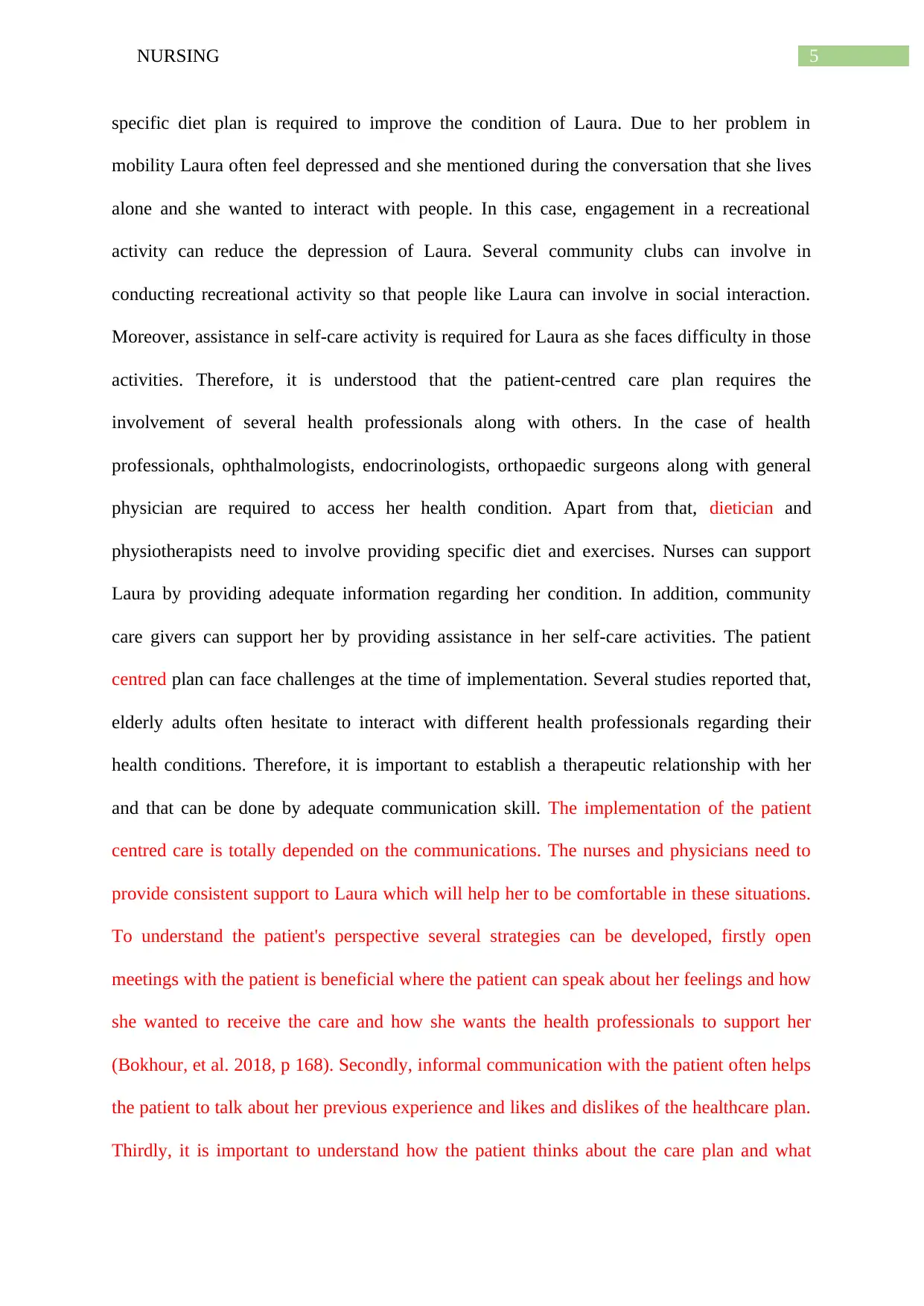
5NURSING
specific diet plan is required to improve the condition of Laura. Due to her problem in
mobility Laura often feel depressed and she mentioned during the conversation that she lives
alone and she wanted to interact with people. In this case, engagement in a recreational
activity can reduce the depression of Laura. Several community clubs can involve in
conducting recreational activity so that people like Laura can involve in social interaction.
Moreover, assistance in self-care activity is required for Laura as she faces difficulty in those
activities. Therefore, it is understood that the patient-centred care plan requires the
involvement of several health professionals along with others. In the case of health
professionals, ophthalmologists, endocrinologists, orthopaedic surgeons along with general
physician are required to access her health condition. Apart from that, dietician and
physiotherapists need to involve providing specific diet and exercises. Nurses can support
Laura by providing adequate information regarding her condition. In addition, community
care givers can support her by providing assistance in her self-care activities. The patient
centred plan can face challenges at the time of implementation. Several studies reported that,
elderly adults often hesitate to interact with different health professionals regarding their
health conditions. Therefore, it is important to establish a therapeutic relationship with her
and that can be done by adequate communication skill. The implementation of the patient
centred care is totally depended on the communications. The nurses and physicians need to
provide consistent support to Laura which will help her to be comfortable in these situations.
To understand the patient's perspective several strategies can be developed, firstly open
meetings with the patient is beneficial where the patient can speak about her feelings and how
she wanted to receive the care and how she wants the health professionals to support her
(Bokhour, et al. 2018, p 168). Secondly, informal communication with the patient often helps
the patient to talk about her previous experience and likes and dislikes of the healthcare plan.
Thirdly, it is important to understand how the patient thinks about the care plan and what
specific diet plan is required to improve the condition of Laura. Due to her problem in
mobility Laura often feel depressed and she mentioned during the conversation that she lives
alone and she wanted to interact with people. In this case, engagement in a recreational
activity can reduce the depression of Laura. Several community clubs can involve in
conducting recreational activity so that people like Laura can involve in social interaction.
Moreover, assistance in self-care activity is required for Laura as she faces difficulty in those
activities. Therefore, it is understood that the patient-centred care plan requires the
involvement of several health professionals along with others. In the case of health
professionals, ophthalmologists, endocrinologists, orthopaedic surgeons along with general
physician are required to access her health condition. Apart from that, dietician and
physiotherapists need to involve providing specific diet and exercises. Nurses can support
Laura by providing adequate information regarding her condition. In addition, community
care givers can support her by providing assistance in her self-care activities. The patient
centred plan can face challenges at the time of implementation. Several studies reported that,
elderly adults often hesitate to interact with different health professionals regarding their
health conditions. Therefore, it is important to establish a therapeutic relationship with her
and that can be done by adequate communication skill. The implementation of the patient
centred care is totally depended on the communications. The nurses and physicians need to
provide consistent support to Laura which will help her to be comfortable in these situations.
To understand the patient's perspective several strategies can be developed, firstly open
meetings with the patient is beneficial where the patient can speak about her feelings and how
she wanted to receive the care and how she wants the health professionals to support her
(Bokhour, et al. 2018, p 168). Secondly, informal communication with the patient often helps
the patient to talk about her previous experience and likes and dislikes of the healthcare plan.
Thirdly, it is important to understand how the patient thinks about the care plan and what
⊘ This is a preview!⊘
Do you want full access?
Subscribe today to unlock all pages.

Trusted by 1+ million students worldwide
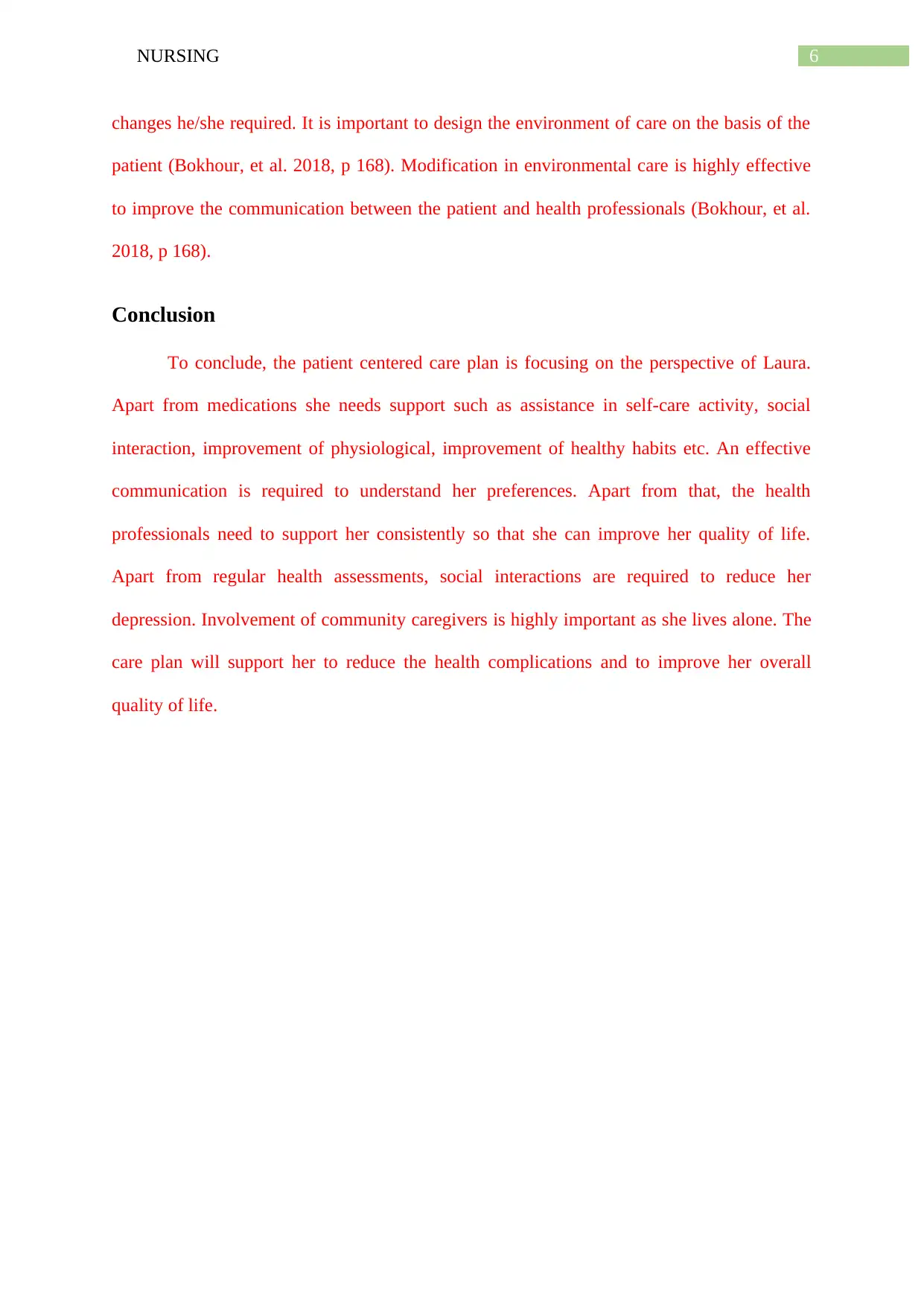
6NURSING
changes he/she required. It is important to design the environment of care on the basis of the
patient (Bokhour, et al. 2018, p 168). Modification in environmental care is highly effective
to improve the communication between the patient and health professionals (Bokhour, et al.
2018, p 168).
Conclusion
To conclude, the patient centered care plan is focusing on the perspective of Laura.
Apart from medications she needs support such as assistance in self-care activity, social
interaction, improvement of physiological, improvement of healthy habits etc. An effective
communication is required to understand her preferences. Apart from that, the health
professionals need to support her consistently so that she can improve her quality of life.
Apart from regular health assessments, social interactions are required to reduce her
depression. Involvement of community caregivers is highly important as she lives alone. The
care plan will support her to reduce the health complications and to improve her overall
quality of life.
changes he/she required. It is important to design the environment of care on the basis of the
patient (Bokhour, et al. 2018, p 168). Modification in environmental care is highly effective
to improve the communication between the patient and health professionals (Bokhour, et al.
2018, p 168).
Conclusion
To conclude, the patient centered care plan is focusing on the perspective of Laura.
Apart from medications she needs support such as assistance in self-care activity, social
interaction, improvement of physiological, improvement of healthy habits etc. An effective
communication is required to understand her preferences. Apart from that, the health
professionals need to support her consistently so that she can improve her quality of life.
Apart from regular health assessments, social interactions are required to reduce her
depression. Involvement of community caregivers is highly important as she lives alone. The
care plan will support her to reduce the health complications and to improve her overall
quality of life.
Paraphrase This Document
Need a fresh take? Get an instant paraphrase of this document with our AI Paraphraser
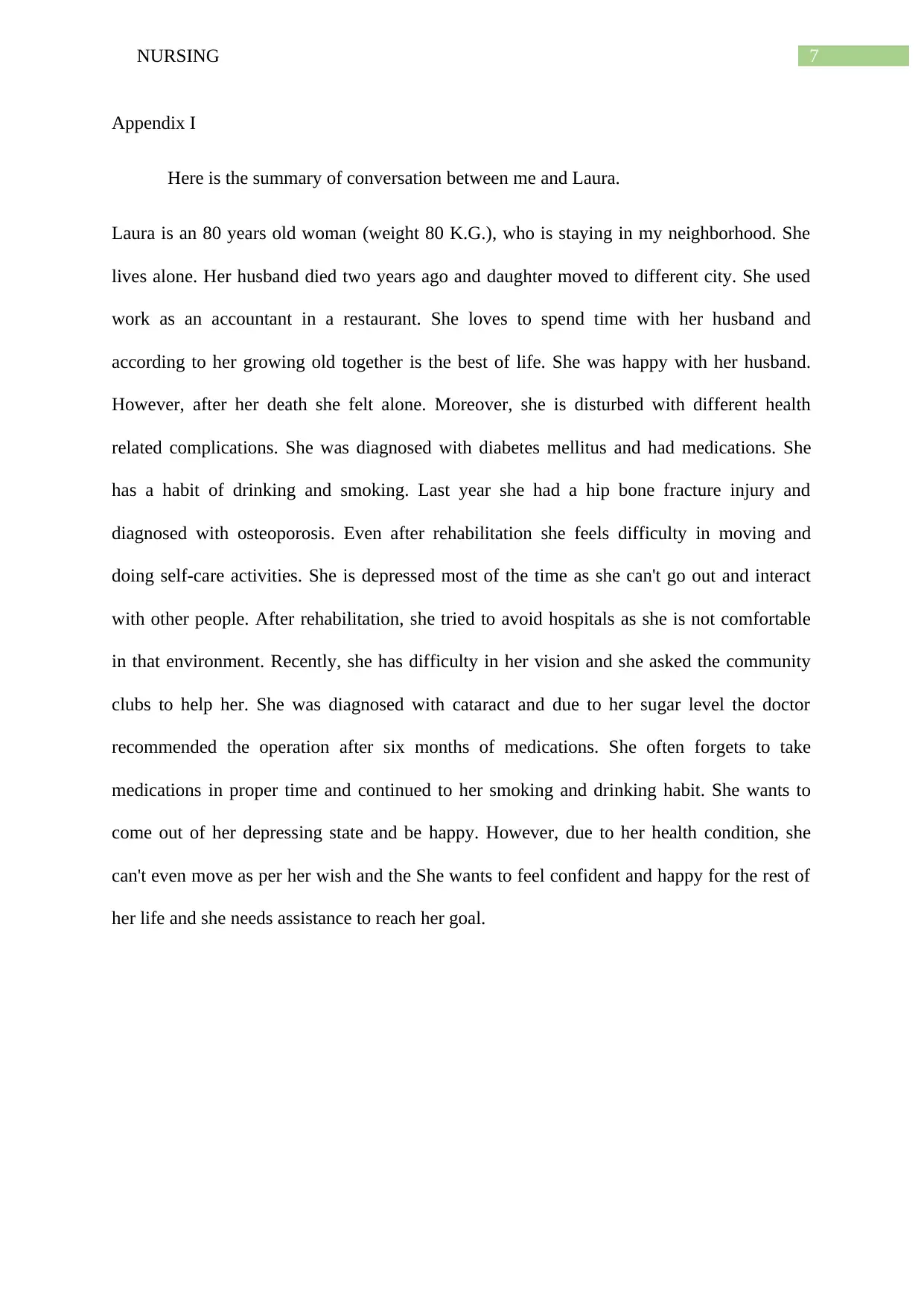
7NURSING
Appendix I
Here is the summary of conversation between me and Laura.
Laura is an 80 years old woman (weight 80 K.G.), who is staying in my neighborhood. She
lives alone. Her husband died two years ago and daughter moved to different city. She used
work as an accountant in a restaurant. She loves to spend time with her husband and
according to her growing old together is the best of life. She was happy with her husband.
However, after her death she felt alone. Moreover, she is disturbed with different health
related complications. She was diagnosed with diabetes mellitus and had medications. She
has a habit of drinking and smoking. Last year she had a hip bone fracture injury and
diagnosed with osteoporosis. Even after rehabilitation she feels difficulty in moving and
doing self-care activities. She is depressed most of the time as she can't go out and interact
with other people. After rehabilitation, she tried to avoid hospitals as she is not comfortable
in that environment. Recently, she has difficulty in her vision and she asked the community
clubs to help her. She was diagnosed with cataract and due to her sugar level the doctor
recommended the operation after six months of medications. She often forgets to take
medications in proper time and continued to her smoking and drinking habit. She wants to
come out of her depressing state and be happy. However, due to her health condition, she
can't even move as per her wish and the She wants to feel confident and happy for the rest of
her life and she needs assistance to reach her goal.
Appendix I
Here is the summary of conversation between me and Laura.
Laura is an 80 years old woman (weight 80 K.G.), who is staying in my neighborhood. She
lives alone. Her husband died two years ago and daughter moved to different city. She used
work as an accountant in a restaurant. She loves to spend time with her husband and
according to her growing old together is the best of life. She was happy with her husband.
However, after her death she felt alone. Moreover, she is disturbed with different health
related complications. She was diagnosed with diabetes mellitus and had medications. She
has a habit of drinking and smoking. Last year she had a hip bone fracture injury and
diagnosed with osteoporosis. Even after rehabilitation she feels difficulty in moving and
doing self-care activities. She is depressed most of the time as she can't go out and interact
with other people. After rehabilitation, she tried to avoid hospitals as she is not comfortable
in that environment. Recently, she has difficulty in her vision and she asked the community
clubs to help her. She was diagnosed with cataract and due to her sugar level the doctor
recommended the operation after six months of medications. She often forgets to take
medications in proper time and continued to her smoking and drinking habit. She wants to
come out of her depressing state and be happy. However, due to her health condition, she
can't even move as per her wish and the She wants to feel confident and happy for the rest of
her life and she needs assistance to reach her goal.
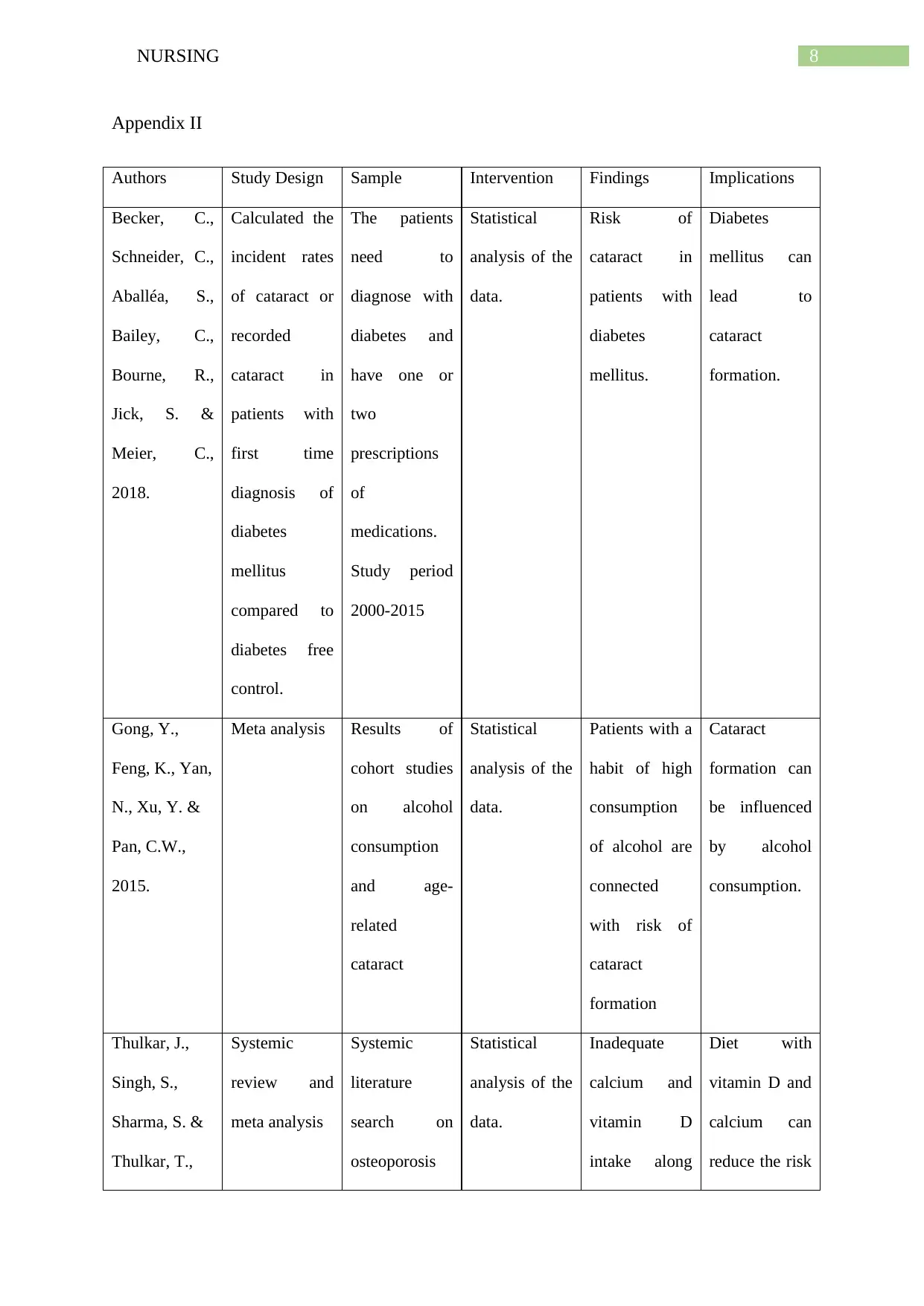
8NURSING
Appendix II
Authors Study Design Sample Intervention Findings Implications
Becker, C.,
Schneider, C.,
Aballéa, S.,
Bailey, C.,
Bourne, R.,
Jick, S. &
Meier, C.,
2018.
Calculated the
incident rates
of cataract or
recorded
cataract in
patients with
first time
diagnosis of
diabetes
mellitus
compared to
diabetes free
control.
The patients
need to
diagnose with
diabetes and
have one or
two
prescriptions
of
medications.
Study period
2000-2015
Statistical
analysis of the
data.
Risk of
cataract in
patients with
diabetes
mellitus.
Diabetes
mellitus can
lead to
cataract
formation.
Gong, Y.,
Feng, K., Yan,
N., Xu, Y. &
Pan, C.W.,
2015.
Meta analysis Results of
cohort studies
on alcohol
consumption
and age-
related
cataract
Statistical
analysis of the
data.
Patients with a
habit of high
consumption
of alcohol are
connected
with risk of
cataract
formation
Cataract
formation can
be influenced
by alcohol
consumption.
Thulkar, J.,
Singh, S.,
Sharma, S. &
Thulkar, T.,
Systemic
review and
meta analysis
Systemic
literature
search on
osteoporosis
Statistical
analysis of the
data.
Inadequate
calcium and
vitamin D
intake along
Diet with
vitamin D and
calcium can
reduce the risk
Appendix II
Authors Study Design Sample Intervention Findings Implications
Becker, C.,
Schneider, C.,
Aballéa, S.,
Bailey, C.,
Bourne, R.,
Jick, S. &
Meier, C.,
2018.
Calculated the
incident rates
of cataract or
recorded
cataract in
patients with
first time
diagnosis of
diabetes
mellitus
compared to
diabetes free
control.
The patients
need to
diagnose with
diabetes and
have one or
two
prescriptions
of
medications.
Study period
2000-2015
Statistical
analysis of the
data.
Risk of
cataract in
patients with
diabetes
mellitus.
Diabetes
mellitus can
lead to
cataract
formation.
Gong, Y.,
Feng, K., Yan,
N., Xu, Y. &
Pan, C.W.,
2015.
Meta analysis Results of
cohort studies
on alcohol
consumption
and age-
related
cataract
Statistical
analysis of the
data.
Patients with a
habit of high
consumption
of alcohol are
connected
with risk of
cataract
formation
Cataract
formation can
be influenced
by alcohol
consumption.
Thulkar, J.,
Singh, S.,
Sharma, S. &
Thulkar, T.,
Systemic
review and
meta analysis
Systemic
literature
search on
osteoporosis
Statistical
analysis of the
data.
Inadequate
calcium and
vitamin D
intake along
Diet with
vitamin D and
calcium can
reduce the risk
⊘ This is a preview!⊘
Do you want full access?
Subscribe today to unlock all pages.

Trusted by 1+ million students worldwide
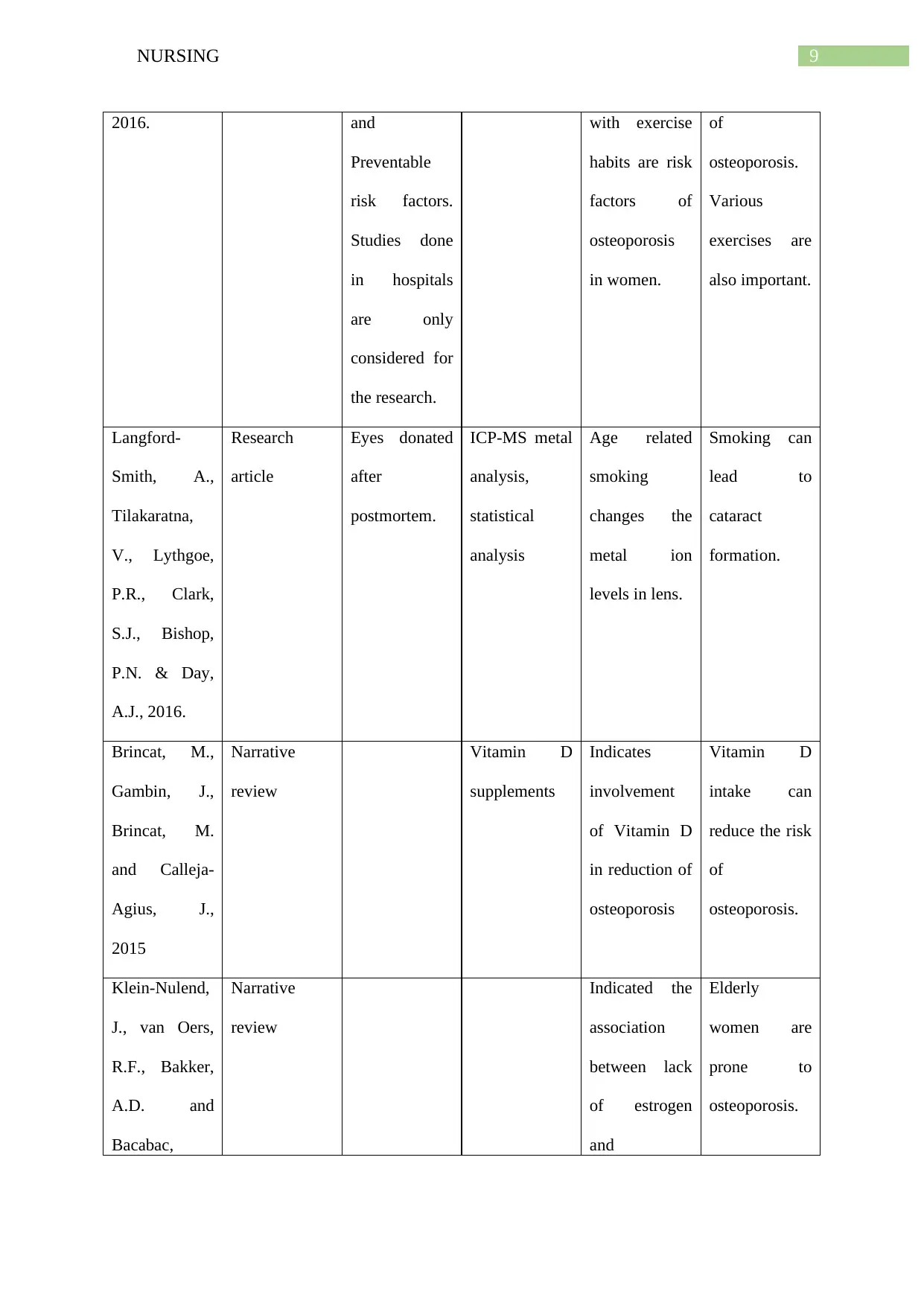
9NURSING
2016. and
Preventable
risk factors.
Studies done
in hospitals
are only
considered for
the research.
with exercise
habits are risk
factors of
osteoporosis
in women.
of
osteoporosis.
Various
exercises are
also important.
Langford-
Smith, A.,
Tilakaratna,
V., Lythgoe,
P.R., Clark,
S.J., Bishop,
P.N. & Day,
A.J., 2016.
Research
article
Eyes donated
after
postmortem.
ICP-MS metal
analysis,
statistical
analysis
Age related
smoking
changes the
metal ion
levels in lens.
Smoking can
lead to
cataract
formation.
Brincat, M.,
Gambin, J.,
Brincat, M.
and Calleja-
Agius, J.,
2015
Narrative
review
Vitamin D
supplements
Indicates
involvement
of Vitamin D
in reduction of
osteoporosis
Vitamin D
intake can
reduce the risk
of
osteoporosis.
Klein-Nulend,
J., van Oers,
R.F., Bakker,
A.D. and
Bacabac,
Narrative
review
Indicated the
association
between lack
of estrogen
and
Elderly
women are
prone to
osteoporosis.
2016. and
Preventable
risk factors.
Studies done
in hospitals
are only
considered for
the research.
with exercise
habits are risk
factors of
osteoporosis
in women.
of
osteoporosis.
Various
exercises are
also important.
Langford-
Smith, A.,
Tilakaratna,
V., Lythgoe,
P.R., Clark,
S.J., Bishop,
P.N. & Day,
A.J., 2016.
Research
article
Eyes donated
after
postmortem.
ICP-MS metal
analysis,
statistical
analysis
Age related
smoking
changes the
metal ion
levels in lens.
Smoking can
lead to
cataract
formation.
Brincat, M.,
Gambin, J.,
Brincat, M.
and Calleja-
Agius, J.,
2015
Narrative
review
Vitamin D
supplements
Indicates
involvement
of Vitamin D
in reduction of
osteoporosis
Vitamin D
intake can
reduce the risk
of
osteoporosis.
Klein-Nulend,
J., van Oers,
R.F., Bakker,
A.D. and
Bacabac,
Narrative
review
Indicated the
association
between lack
of estrogen
and
Elderly
women are
prone to
osteoporosis.
Paraphrase This Document
Need a fresh take? Get an instant paraphrase of this document with our AI Paraphraser

10NURSING
R.G., 2015. osteoporosis.
R.G., 2015. osteoporosis.
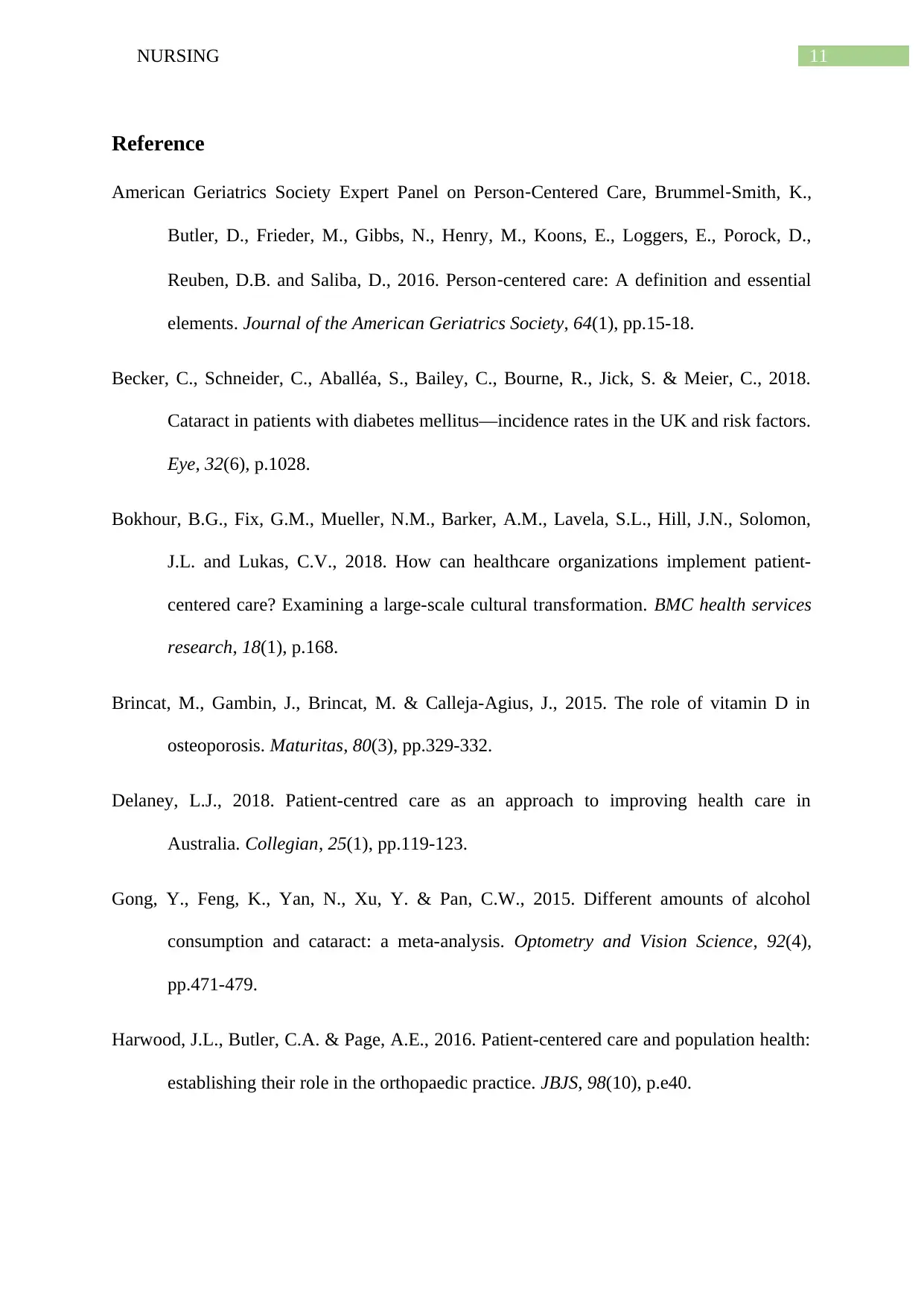
11NURSING
Reference
American Geriatrics Society Expert Panel on Person‐Centered Care, Brummel‐Smith, K.,
Butler, D., Frieder, M., Gibbs, N., Henry, M., Koons, E., Loggers, E., Porock, D.,
Reuben, D.B. and Saliba, D., 2016. Person‐centered care: A definition and essential
elements. Journal of the American Geriatrics Society, 64(1), pp.15-18.
Becker, C., Schneider, C., Aballéa, S., Bailey, C., Bourne, R., Jick, S. & Meier, C., 2018.
Cataract in patients with diabetes mellitus—incidence rates in the UK and risk factors.
Eye, 32(6), p.1028.
Bokhour, B.G., Fix, G.M., Mueller, N.M., Barker, A.M., Lavela, S.L., Hill, J.N., Solomon,
J.L. and Lukas, C.V., 2018. How can healthcare organizations implement patient-
centered care? Examining a large-scale cultural transformation. BMC health services
research, 18(1), p.168.
Brincat, M., Gambin, J., Brincat, M. & Calleja-Agius, J., 2015. The role of vitamin D in
osteoporosis. Maturitas, 80(3), pp.329-332.
Delaney, L.J., 2018. Patient-centred care as an approach to improving health care in
Australia. Collegian, 25(1), pp.119-123.
Gong, Y., Feng, K., Yan, N., Xu, Y. & Pan, C.W., 2015. Different amounts of alcohol
consumption and cataract: a meta-analysis. Optometry and Vision Science, 92(4),
pp.471-479.
Harwood, J.L., Butler, C.A. & Page, A.E., 2016. Patient-centered care and population health:
establishing their role in the orthopaedic practice. JBJS, 98(10), p.e40.
Reference
American Geriatrics Society Expert Panel on Person‐Centered Care, Brummel‐Smith, K.,
Butler, D., Frieder, M., Gibbs, N., Henry, M., Koons, E., Loggers, E., Porock, D.,
Reuben, D.B. and Saliba, D., 2016. Person‐centered care: A definition and essential
elements. Journal of the American Geriatrics Society, 64(1), pp.15-18.
Becker, C., Schneider, C., Aballéa, S., Bailey, C., Bourne, R., Jick, S. & Meier, C., 2018.
Cataract in patients with diabetes mellitus—incidence rates in the UK and risk factors.
Eye, 32(6), p.1028.
Bokhour, B.G., Fix, G.M., Mueller, N.M., Barker, A.M., Lavela, S.L., Hill, J.N., Solomon,
J.L. and Lukas, C.V., 2018. How can healthcare organizations implement patient-
centered care? Examining a large-scale cultural transformation. BMC health services
research, 18(1), p.168.
Brincat, M., Gambin, J., Brincat, M. & Calleja-Agius, J., 2015. The role of vitamin D in
osteoporosis. Maturitas, 80(3), pp.329-332.
Delaney, L.J., 2018. Patient-centred care as an approach to improving health care in
Australia. Collegian, 25(1), pp.119-123.
Gong, Y., Feng, K., Yan, N., Xu, Y. & Pan, C.W., 2015. Different amounts of alcohol
consumption and cataract: a meta-analysis. Optometry and Vision Science, 92(4),
pp.471-479.
Harwood, J.L., Butler, C.A. & Page, A.E., 2016. Patient-centered care and population health:
establishing their role in the orthopaedic practice. JBJS, 98(10), p.e40.
⊘ This is a preview!⊘
Do you want full access?
Subscribe today to unlock all pages.

Trusted by 1+ million students worldwide
1 out of 14
Related Documents
Your All-in-One AI-Powered Toolkit for Academic Success.
+13062052269
info@desklib.com
Available 24*7 on WhatsApp / Email
![[object Object]](/_next/static/media/star-bottom.7253800d.svg)
Unlock your academic potential
Copyright © 2020–2025 A2Z Services. All Rights Reserved. Developed and managed by ZUCOL.





